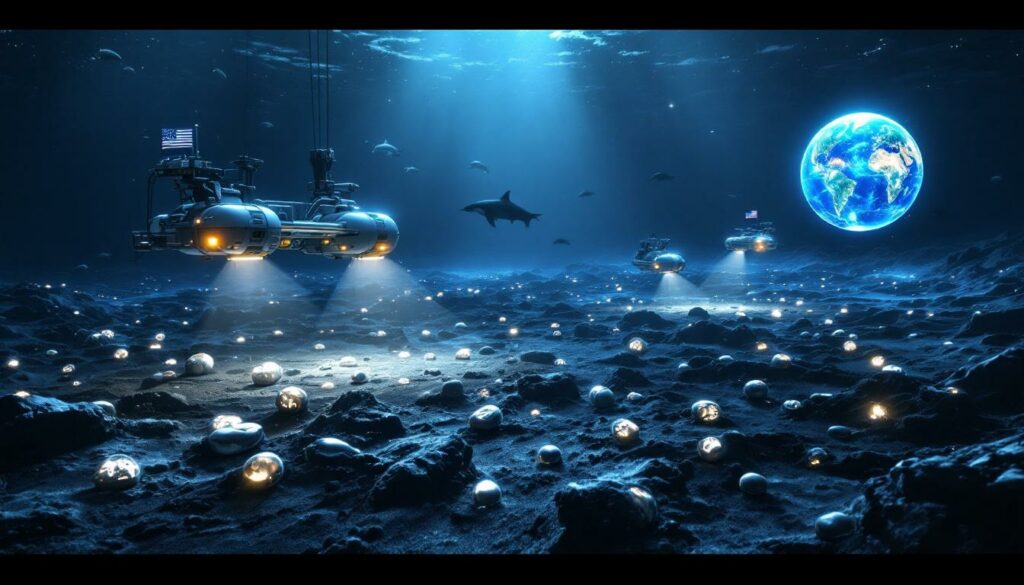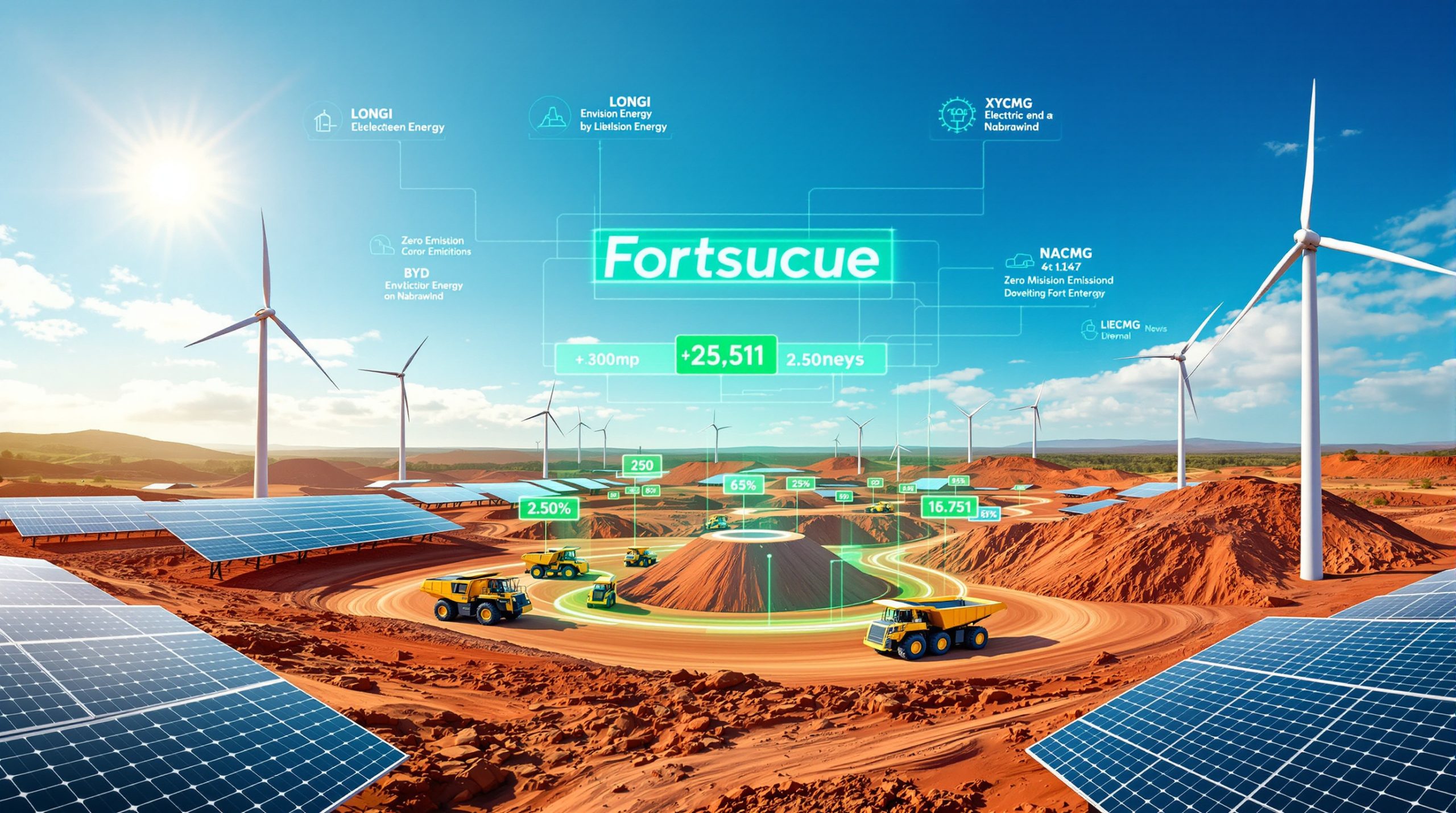What is Driving the US Interest in Deep-Sea Mining?
The United States is making significant moves to secure its critical mineral supply chain through deep-sea mining initiatives. President Donald Trump's executive order, "Unleashing America's Offshore Critical Minerals and Resources," marks a strategic pivot toward ocean floor resources as part of a broader minerals acquisition strategy that previously focused on regions like Ukraine and Greenland. This directive instructs federal departments to explore utilizing the National Defense Stockpile for seabed minerals, signaling a serious commitment to oceanic resource development.
The executive order represents a response to growing concerns about mineral security in an increasingly competitive global landscape. By targeting offshore resources, the US aims to reduce dependence on foreign nations for materials that underpin both military capabilities and civilian technologies.
The Trump Administration's Critical Minerals Strategy
The administration's approach reflects a fundamental shift in resource security thinking. Rather than relying solely on traditional international trade relationships or terrestrial mining operations within allied nations, the US is now looking to the vast, largely untapped potential of its maritime territories.
"This initiative represents a crucial step toward securing America's industrial future through domestic resource development," notes a senior administration official familiar with the strategy. "We're no longer content to remain dependent on potentially unreliable foreign sources for minerals essential to our national security and economic prosperity."
The directive specifically prioritizes the exploration and potential extraction of minerals from areas under US jurisdiction, creating a pathway for American companies to develop these resources with government support and regulatory certainty.
Critical Minerals in Deep-Sea Deposits
The ocean floor holds remarkable concentrations of valuable minerals, particularly in the form of polymetallic nodules. These potato-sized concretions contain significant amounts of nickel, copper, cobalt, and manganese—all designated as critical minerals energy transition in US strategic planning documents.
These deep-sea deposits are particularly attractive because:
- They form naturally on the seabed through mineral precipitation over millions of years
- They can be collected without traditional mining techniques like drilling or blasting
- They often contain higher concentrations of valuable metals than terrestrial deposits
- They require no overburden removal or waste rock management
What makes these underwater resources especially valuable is their composition. Cobalt, for instance, is essential for lithium-ion batteries that power electric vehicles and renewable energy storage systems. The US currently imports approximately 75% of its cobalt, with the Democratic Republic of Congo supplying the majority—a supply chain vulnerability the administration seeks to address through alternative sourcing.
The strategic shift toward ocean floor minerals also aligns with the broader objective of securing supply chains for the technologies that will define America's industrial and military capabilities in the coming decades.
How Vast is the Deep-Sea Mineral Potential?
The scale of mineral resources on the ocean floor is almost difficult to comprehend. Industry analysts estimate global subsea metal resources at approximately 250 trillion tonnes—a figure that dwarfs known terrestrial reserves by a factor of twenty. This represents potentially the largest untapped mineral resource on the planet, one that could fundamentally reshape global supply chains if successfully developed.
"We're talking about a resource base that could theoretically supply global demand for certain minerals for centuries," explains Dr. James Hein, marine geologist with extensive experience studying deep-sea mineral formations. "The challenge has never been about the quantity of resources, but rather the technical and environmental questions surrounding their extraction."
The Unprecedented Scale of Subsea Resources
The Clarion-Clipperton Zone (CCZ), located in the Pacific Ocean between Hawaii and Mexico, represents one of the richest concentrations of polymetallic nodules benefits on Earth. Spanning approximately 4.5 million square kilometers, this abyssal plain hosts trillions of these mineral-rich nodules scattered across the seabed at depths of 4,000-6,000 meters.
Research vessels mapping this region have documented nodule concentrations reaching 15 kg per square meter in some areas. These nodules typically contain:
- 1.0-1.4% nickel
- 0.9-1.3% copper
- 0.2-0.25% cobalt
- 27-30% manganese
When calculated across the full expanse of the CCZ, these percentages translate to hundreds of millions of tonnes of critical minerals—resources that could potentially reduce or eliminate dependence on foreign suppliers for decades.
The Mining Co's Groundbreaking Application
At the forefront of this emerging industry is The Metals Company (TMC), which has submitted the world's first application for commercial recovery of deep-sea minerals under the US seabed mining code. This historic filing covers an extensive area of 25,160 square kilometers with significant indicated and measured resources.
TMC CEO Gerard Barron has positioned the company as a pioneer in this space: "We have invested over half a billion dollars and have spent more than a decade preparing for this moment… building the world's most advanced deep-sea minerals platform."
Beyond its commercial recovery application, TMC has filed two additional exploration license applications covering a combined area of 199,895 square kilometers—a territory larger than the state of South Dakota. These applications represent the first step toward establishing large-scale mineral recovery operations in international waters.
Resource Quantification and Exploration Potential
In its SEC filings, TMC reports compliance with SK 1300 standards for resource estimation, claiming 1,635 million wet tonnes of polymetallic nodules in its contract areas. The company estimates an additional 500 million tonnes of exploration upside potential across its license areas.
To put these figures in perspective:
| Metal | TMC Resource Estimate | Current Annual Global Production | Years of Supply |
|---|---|---|---|
| Nickel | 18.1 million tonnes | 2.6 million tonnes | ~7 years |
| Copper | 20.6 million tonnes | 21 million tonnes | ~1 year |
| Cobalt | 4.0 million tonnes | 170,000 tonnes | ~23 years |
| Manganese | 470 million tonnes | 20 million tonnes | ~23 years |
Over the past decade, TMC has invested more than $500 million in developing its deep-sea minerals platform, funding scientific research, engineering development, and environmental baseline studies. This significant investment underscores the company's commitment to commercializing deep-sea mineral resources despite the considerable challenges involved.
What Technical and Environmental Challenges Exist?
The development of deep-sea mining has been hindered by formidable technical challenges inherent to operating in one of Earth's most extreme environments. The abyssal plains targeted for nodule collection lie 4,000-6,000 meters below the ocean surface—depths where pressure exceeds 400-600 atmospheres, temperatures hover just above freezing, and total darkness prevails.
"Working at these depths requires completely rethinking conventional mining approaches," explains marine engineering consultant Dr. Robert Ballard. "Every component must withstand crushing pressure, function reliably in a corrosive saltwater environment, and operate with minimal human intervention."
Technical Barriers to Deep-Sea Mining
Creating viable deep-sea mining systems requires overcoming several significant technical hurdles:
- Extreme Pressure Resistance – Equipment must withstand pressures exceeding 400 atmospheres
- Remote Operation – All systems must function autonomously or through remote control
- Nodule Collection Efficiency – Selective harvesting systems must minimize seafloor disturbance
- Vertical Transport – Collected materials must be lifted 4-6 kilometers to surface vessels
- Seafloor Mapping – High-resolution imaging and sampling of vast areas is required
- Weather Resilience – Surface operations must withstand harsh ocean conditions
- Maintenance Challenges – Repairs at depth require specialized intervention
TMC claims to have built "the world's most advanced deep-sea minerals platform" through its decade-long investment in science, engineering, and technology. The company has conducted multiple at-sea trials of its nodule collection system, demonstrating the functionality of key components while acknowledging that full-scale commercial operations will require further refinement.
Growing Environmental Opposition
As technical solutions advance, environmental concerns have intensified. Scientific surveys have confirmed the presence of vulnerable whale and dolphin species in TMC's target areas, raising questions about potential impacts on marine mammals.
Dr. Kirsten Young from the University of Exeter, who led recent research in the region, reports: "We already knew that the Clarion-Clipperton Zone is home to at least 20 species of cetaceans, but we've now demonstrated their presence in two areas specifically earmarked for deep-sea mining by TMC."
Environmental concerns about deep-sea mining opposition include:
- Destruction of seafloor habitats that have evolved over millions of years
- Sediment plumes that could disperse for kilometers, affecting filter-feeding organisms
- Noise pollution potentially disrupting marine mammal communication and navigation
- Light pollution in a naturally dark environment
- Disruption of carbon sequestration functions on the deep ocean floor
- Potential release of stored carbon from disturbed sediments
These concerns have fueled growing calls for a moratorium on deep-sea mining at recent UN Ocean Conferences, with environmental advocates arguing that too little is known about these ecosystems to risk widespread industrial activity.
International Regulatory Landscape
The regulatory environment for deep-sea mining has become increasingly complex, with 37 countries now supporting a moratorium on the practice. Four nations recently joined this position, signaling growing international concern about potential environmental impacts.
The UN Secretary-General has issued a strong call to halt the industry's development until sufficient scientific understanding and regulatory frameworks are established. This creates a tension between:
- National interests in securing critical mineral supply chains
- International efforts to protect shared ocean resources
- Scientific calls for precautionary approaches
- Industry pressure for regulatory certainty
"The deep ocean represents humanity's last great frontier on Earth. Before we exploit these resources, we must understand what we risk losing." — UN Secretary-General (2024 Ocean Conference)
This regulatory uncertainty presents a significant challenge for companies like TMC that have invested heavily in developing deep-sea mining capabilities. Without clear international consensus on exploitation regulations, the path to commercial operations remains uncertain despite national-level permitting progress.
How Might Deep-Sea Mining Impact Global Mineral Markets?
The emergence of commercial deep-sea mining could fundamentally reshape global mineral markets, introducing an entirely new source of critical metals at potentially significant scale. This disruption would affect not only pricing dynamics but also geopolitical relationships built around mineral supply chains.
"We're looking at a potential paradigm shift in how critical minerals are sourced," explains resource economist Dr. Eleanor Prescott. "Nations that have traditionally leveraged their terrestrial mineral wealth for geopolitical advantage could see that influence diminish as ocean resources become viable."
Potential Supply Chain Disruption
Deep-sea mining could significantly alter established mineral supply patterns that have shaped international relations for decades. Currently, critical mineral production is concentrated in a relatively small number of countries:
- Cobalt: Democratic Republic of Congo (70% of global production)
- Nickel: Indonesia, Philippines, and Russia (collectively ~60%)
- Manganese: South Africa, Australia, and Gabon (collectively ~65%)
- Copper: Chile and Peru (collectively ~40%)
The introduction of deep-sea sources could reduce market concentration and potentially stabilize prices by diversifying supply. Industry analysts project that commercial deep-sea mining could potentially supply:
- 15-20% of global cobalt demand by 2035
- 5-10% of global nickel demand by 2035
- 3-7% of global copper demand by 2035
- 10-15% of global manganese demand by 2035
These projections suggest that while deep-sea mining won't immediately dominate mineral markets, it could establish itself as a significant alternative source that reduces reliance on traditional mining nations.
Investment and Economic Implications
TMC's CEO Gerard Barron has expressed confidence in delivering "the world's first commercial nodule project" with the support of the US government. The company envisions helping "power a new era of American industrial strength" through domestic supply chain development.
For investors, deep-sea mining represents both opportunity and risk:
| Potential Opportunities | Key Risks |
|---|---|
| First-mover advantage in emerging industry | Regulatory uncertainty and potential moratorium |
| Access to large, high-grade mineral resources | Environmental opposition and reputational concerns |
| Lower production costs compared to some land mines | Unproven commercial-scale technology |
| Reduced exposure to geopolitical risks | Weather and operational challenges at sea |
| Potential premium for "environmentally superior" metals | Legal challenges from environmental groups |
The economic viability of deep-sea mining will ultimately depend on several factors:
- Regulatory certainty allowing for long-term investment planning
- Technology costs for specialized collection and processing equipment
- Environmental compliance requirements affecting operational parameters
- Market prices for target minerals (cobalt, nickel, copper, manganese)
- Processing innovations optimizing metal recovery from nodules
Industry projections suggest initial capital expenditures of $2-4 billion for a commercial-scale deep-sea mining operation, with production costs potentially competitive with mid-tier terrestrial mines once at scale.
What's the Outlook for Deep-Sea Mining Regulation?
The regulatory landscape for deep-sea mining remains in flux, with competing national interests, environmental concerns, and industry pressures creating a complex governance challenge. The United States is actively developing a seabed mining code to govern offshore mineral extraction within its Exclusive Economic Zone, potentially creating a pathway for emerging deep-sea miners like TMC to begin operations.
However, international opposition to deep-sea mining continues to grow despite US initiatives. This creates a fundamental tension between national mineral security strategies and global ocean governance principles.
The Evolving Regulatory Framework
The US regulatory approach focuses on balancing resource development with environmental protection through a framework that includes:
- Mandatory environmental impact assessments
- Baseline data collection requirements
- Monitoring protocols during and after operations
- Financial security for environmental remediation
- Technology standards for collection equipment
This national-level framework exists alongside the International Seabed Authority (ISA), which governs mineral resources in areas beyond national jurisdiction under the UN Convention on the Law of the Sea. The ISA has been working to develop exploitation regulations for deep-sea mining, though progress has been slowed by fundamental disagreements about environmental standards and benefit-sharing arrangements.
"We're seeing the emergence of a two-track regulatory system," observes maritime law expert Professor Maria Galdona. "Nations pursuing strategic mineral independence are developing domestic frameworks, while international institutions move more cautiously under pressure from environmental advocates."
This regulatory divergence creates uncertainty for companies and investors contemplating multi-billion dollar investments in deep-sea mining technology and infrastructure.
Balancing Economic and Environmental Priorities
Deep-sea mining presents a classic case of weighing resource security against ecosystem protection—a tension that has defined environmental policy debates for decades. The novelty in this case lies in the frontier nature of the deep ocean, an environment about which scientific understanding remains limited.
Key considerations in this balance include:
- Scientific uncertainty about deep-sea ecosystem recovery rates
- Strategic minerals essential for renewable energy and defense technologies
- Alternative sources including improved recycling and terrestrial mining
- Intergenerational equity regarding ocean resource management
- Precautionary principle application to novel industrial activities
Scientific research continues to document marine biodiversity in potential mining areas, revealing complex ecosystems that have evolved under stable conditions for millions of years. Recent expeditions to the Clarion-Clipperton Zone have discovered hundreds of previously unknown species, raising questions about what might be lost through large-scale industrial activity.
"We discover new species on nearly every deep-sea research expedition. This suggests we're making decisions about ecosystem impacts with very incomplete information." — Dr. Craig Smith, Oceanographer
The path forward likely involves continued development of both technological solutions to minimize environmental impact and regulatory frameworks that ensure adequate protection while enabling responsible resource development. Finding this balance will require unprecedented cooperation between industry, science, government, and environmental stakeholders.
FAQ: Deep-Sea Mining Essentials
What are polymetallic nodules?
Polymetallic nodules are potato-sized rock concretions found on the ocean floor containing valuable metals including nickel, copper, cobalt, and manganese. They form over millions of years as minerals precipitate around a core object like a shark tooth or rock fragment. These nodules typically grow at rates of 1-10mm per million years, making them a non-renewable resource on human timescales.
The nodules lie on the seabed surface, primarily on abyssal plains at depths of 4,000-6,000 meters. Their formation requires specific environmental conditions, including low sedimentation rates and oxygen-rich bottom waters, which explains their concentration in certain regions like the Clarion-Clipperton Zone.
Why is the US interested in deep-sea mining?
The US seeks to secure domestic supply chains for critical minerals essential for clean energy technologies, defense applications, and industrial manufacturing. Deep-sea mining offers potential independence from foreign mineral sources that may be subject to geopolitical risks.
Specific motivations include:
- National security concerns about mineral dependencies on geopolitical competitors
- Energy transition requirements for battery metals like cobalt and nickel
- Supply diversification to reduce vulnerability to market manipulation
- **Industrial policy goals
Want to Capitalise on the Next Major Mineral Discovery?
Stay ahead of the market with Discovery Alert's proprietary Discovery IQ model, which instantly notifies investors of significant ASX mineral discoveries and transforms complex data into actionable insights. Explore historic examples of exceptional returns from major discoveries by visiting the dedicated discoveries page and begin your 30-day free trial today.




